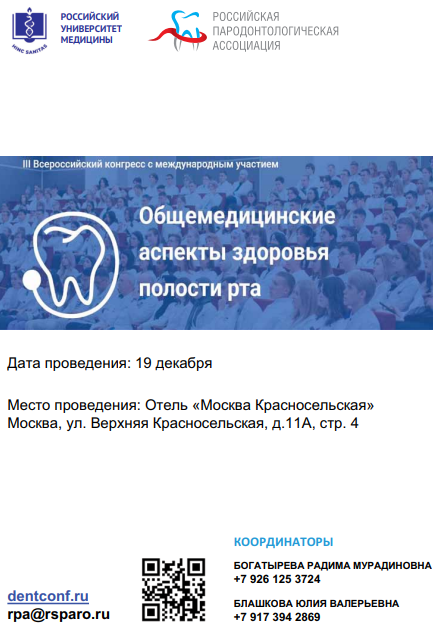Creating a positive position to dental treatment through the correction of psychoemotional status in children with cerebral paralysis
Abstract
Keywords
About the Author
Е.А. ЗалазаеваRussian Federation
References
1. Бадалян Л. О., Журба Л. Т., Тимонина О. В. Детские церебральные параличи. - Киев: Здоровье, 1988.
2. Данилова М. А., Бронников В. А., Залазаева Е. А. Взаимосвязь состояния окклюзии и речевой функции у детей со спастическими формами церебрального паралича // Ортодонтия. 2012. №4 (60). С. 4-7.
3. Данилова М. А., Кирко Г. Е., Залазаева Е. А. Особенности микрокристаллизации слюны и течения кариеса у детей со спастическими формами детского церебрального паралича // Стоматология детского возраста и профилактика. 2012. №3 (42). С. 52-56.
4. Данилова М. А., Мачулина Н. А., Залазаева Е. А. Опыт совместной работы кафедры детской стоматологии и ортодонтии Пермской ГМА и КГАУ «Центр комплексной реабилитации инвалидов» // Стоматология детского возраста и профилактика. 2013. №1 (44). С. 70-72.
5. Данилова М. А., Шевцова Ю. В., Мачулина Н. А. Особенности гистологического строения молочных зубов у детей // Стоматология детского возраста и профилактика. 2013. №4 (47). С. 27-30.
6. Данилова М. А., Царькова О. А., Пономарева М. Л. Структурный анализ факторов риска возникновения зубочелюстных аномалий у детей дошкольного возраста // Стоматология детского возраста и профилактика. 2014. №2. С. 15-17.
7. Данилова М. А., Шевцова Ю. В., Мачулина Н. А. Клинико-морфологические аспекты кариеса молочных зубов // Стоматология детского возраста и профилактика. 2015. №1. С. 7-9.
8. Дурова А. А., Симакова М. Г., Смирнова В. С. Этиология и патогенез внутриутробной инфекции // Акушерство и гинекология. 1995. №6. С. 9-12.
9. Кузьмина Э. М. Профилактика стоматологических заболеваний: учеб. пособие. - М.: Тонга принт, 2001. - 216 с.
10. Кузьмина Э. М. Стоматологическая заболеваемость населения России. - М.: МГМСУ, 2009. - 236 с.
11. Леонтьев В. К. Профилактика стоматологических заболеваний. - М.: МГМСУ, 2006. - 215 с.
12. Михайлов А. В. и соавтр. Особенности течения периода новорожденности у детей с высоким риском внутрикутробного инфицирования / Актуальные вопросы перинатологии: матер. республ. научн.-практ. конф. - Екатеринбург, 1996. - С. 124-127.
13. Сунцов В. Г. Особенности формирования мотивации к гигиене полости рта у детей дошкольного возраста // Клиническая стоматология. 2006. №4. С. 66-68.
14. Уткузова М. А., Морозова Е. А. Диагностика нарушений движения и координации у детей первого года жизни. - Казань, 2003. - 29 с.
15. Andujar M. B., Magloire H. Collagen gene expression and tooth development. An over view // J. de Biologie Buccale. 1999. №2. P. 117-122.
16. Axelsson P. Diagnosis and risk prediction of dental caries. - Quintessence Publishining Co, Inc. 2000. - P. 207.
17. Down F. J. Saliva and dental caries // Dent Clin North Am. 1999. №43 (4). P. 579-597.
18. Edgar W. M., Higham S. M., Manning R. H. Saliva stimulation and caries prevention // Adv Dent Res. 1994. №8 (2). Р. 239-245.
19. Hicks J., Garcia-Godoy F., Flaitz C. Biological factors in dental caries: role of saliva and dental plaque in the dynamic process of demineralization and remineralization (part 1) // J. Clin. Pediatr. Dent. 2003. №28 (1). Р. 47-52.
20. Lenander-Lumikari M., Loimaranta V. Saliva and dental caries // Adv. Dent. Res. 2000. №14. Р. 40-47.
21. Tenovuo J. Salivary parameters of relevance for assessing caries activity in individuals and populations // Community Dent. Oral Epidemiol. 1997. №25 (1). Р. 82-86.
Review
For citations:
Creating a positive position to dental treatment through the correction of psychoemotional status in children with cerebral paralysis. Pediatric dentistry and dental prophylaxis. 2017;16(2):41-44. (In Russ.)




































